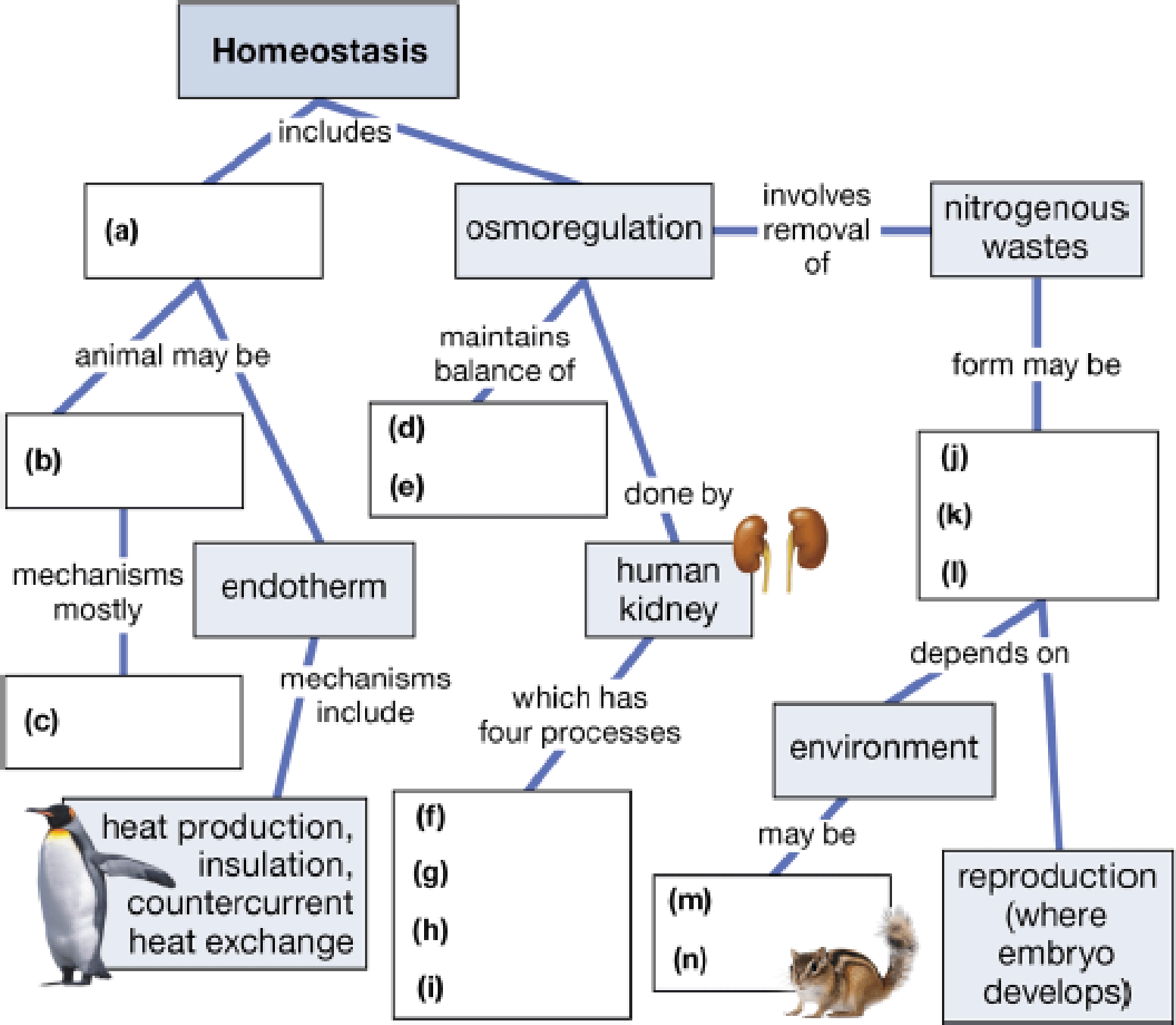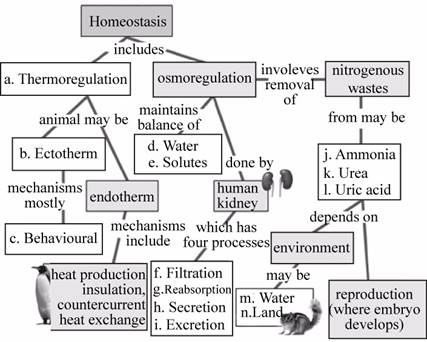
Concept explainers
Complete this map, which presents the three main topics of this chapter.

To complete: The given map representing the three main topics of this chapter.
Concept introduction: The processes such as thermoregulation and Osmoregulation are very essential for maintaining the homeostasis of the body.
The change in constant internal body temperature can impair the activity of enzymes and therefore, can result in death. The disturbance in osmolarity can have similar effects.
Answer to Problem 1CC
Pictorial representation: Fig.1 shows the completed map representing the three main topics of this chapter.

Fig.1: Three main topics of the chapter.
Explanation of Solution
(a)
Correct answer: Thermoregulation
Explanation: Thermoregulation is a homeostatic mechanism in animals that maintains the constant internal body temperature regardless of external temperature fluctuations. Hence the correct answer is thermoregulation.
(b)
Correct answer: Ectotherm
Explanation: Ectotherms are those animals that can regulate their body temperatures by gaining heat from surroundings. Hence, the correct answer is ectotherm.
(c)
Correct answer: Behavioral
Explanation: Ectotherm maintains constant body temperatures by behavioral responses such as huddling, migration and sun bathing. Hence, the correct answer is behavioral response.
(d)
Correct answer: Water
Explanation: The Osmoregulation is a process by which an organism maintains balance of water in the body. Hence, the correct answer is water.
(e)
Correct answer: Solutes
Explanation: The Osmoregulation is a process by which an organism maintains balance of solutes in the body. Hence, the correct answer is solutes.
(f)
Correct answer: Filtration
Explanation: It is one of the four processes by which the kidneys produce urine. In this process, the hydrostatic pressure in the glomerular capillaries drives the filtration of blood. Hence, the correct answer is filtration.
(g)
Correct answer: Reabsorption
Explanation: It is one of the four processes by which the kidneys produce urine. In this process, the essential nutrients such as glucose, amino acids, salts and water are reabsorbed into the blood. Hence the correct answer is reabsorption.
(h)
Correct answer: Secretion
Explanation: It is one of the four processes by which the kidneys produce urine. In this process, the extra ions, drugs and other harmful substances are secreted into the renal tubules and are excreted out of the body. This process takes place in the distal convoluted tubules. Hence, the correct answer is secretion.
(i)
Correct answer: Excretion
Explanation: It is the last process in the urine production. In this process, the harmful waste substances are eliminated from the kidneys in the form of urine. Hence, the correct answer is excretion.
(j)
Correct answer: Ammonia
Explanation: Ammonia is one of the form in which nitrogenous waste can be eliminated. The excretion of nitrogenous waste in the form of ammonia generally occurs in aquatic organisms. Hence the correct answer is ammonia.
(k)
Correct answer: Urea
Explanation: Urea is one of the form in which nitrogenous waste can be eliminated. Many mammals including humans, amphibians and some bony fishes excrete urea. Hence the correct answer is urea.
(l)
Correct answer: Uric acid
Explanation: Uric acid is one of the form in which nitrogenous waste can be eliminated. Many birds, some reptile and some insect excrete uric acid. Hence the correct answer is uric acid.
(m)
Correct answer: Water
Explanation: The form in which the nitrogenous waste is to be excreted depends on the environment, which can be water. Hence the correct answer is water.
(n)
Correct answer: Land
Explanation: The form in which the nitrogenous waste is to be excreted depends on the environment, which can be land. Hence the correct answer is land.
Want to see more full solutions like this?
Chapter 25 Solutions
Campbell Biology: Concepts and Connections
- Price of visit Number of visits $700 0 $600 [1 $500 2 $400 3 $300 4 00000 The Table blow gives the demand curve for doctor visits for Elena. If the price of a doctor's visit is $600, and Elena does not have health insurance, she will visit the doctor times. If Elena obtains 50% coinsurance (the company pays 50% of the medical bill, Elena pays 50%), then Elena will visit the doctor times. 1; 2 0; 3 0; 2 1;4 2; 1arrow_forwardP 200 150- 100 50 w/instrance/ w/insurance 2 100 Demand Assume that the white curve (labeled "Demand") represents an individual's true demand for this particular health care service. The coinsurance associated with insurance option 1 (in blue) is likely _. 0000 100% 25% 50% 0%arrow_forwardUse the figure below. Bob and Nancy have the same income and total utility.. willingness to pay for an insurance premium will be lower than because they are. risk- averse. Total utility Current utility Bob's utility Nancy's utility 0000 Bob; Nancy; less Nancy; Bob; less Nancy; Bob; more Bob; Nancy; more Current Income incomearrow_forward
- Consider the figure below. Suppose the true price of a health care service is P1. Suppose further that the individual has obtained insurance that has a fixed copayment for this particular service. The copayment is represented by price P2. represents the quantity of the service the individual would consume without insurance. quantity of the service the individual would consume with the insurance. Health Care Service represents the P. P₂ a Q1;Q2 Q2; Q3 Q1; Q3 Q3; Q1 Q2; Q1 फ f Q ८ g d h Q3\D 7Q 00000arrow_forwardThe table shows the utility Jordan receives at various income levels, but they do not know what their income will be next year. There is a 15% chance their income will be $25,000, a 20% chance their income will be $35,000, and a 65% chance their income will be $45,000. We know that Jordan is Income $25,000 Utility 2,800 30,000 3,200 35,000 3,500 40,000 3,700 45,000 3,800 ☐ none of the above 0 000 risk taker (lover) because their marginal utility of income is increasing risk neutral because their marginal utility of income is constant risk averse because their marginal utility of income is decreasing risk neutral because their marginal utility of income is decreasingarrow_forwardOOOO a d+e d a+b+c Consider the figure below. Suppose the true price of a health care service is P1. Suppose further that the individual has obtained insurance that has a fixed copayment for this particular service. The copayment is represented by price P2. The social loss from moral hazard if the individual has copayment P2 is represented graphically by the area(s): Health Care Service P. a No 4 ८ e g Q2 Q3 Darrow_forward
- OOO O The table shows the utility Jordan receives at various income levels, but they do not know what their income will be next year. There is a 15% chance their income will be $25,000, a 20% chance their income will be $35,000, and a 65% chance their income will be $45,000. We know that Jordan's expected income is. Their utility from their expected income is_ Income $25,000 Utility 2,800 30,000 3,200 35,000 3,500 40,000 3,700 45,000 3,800 $45,000; 3,800 $40,000; 3,700 $25,000; 2,800 $35,000; 3,500 $30,000; 3,200arrow_forwardQuestion 1 Classify the Bird Mark 7; how is it: Powered Triggered Cycled Classify brid mark 7 Powered: By gas (oxygen) Triggered: Negative Pressure, caused by the patient’s inspiratory effort Cycled: The machine stops delivering gas and allows for exhalationarrow_forwardHypothetical "pedigree" for Sickle Cellarrow_forward
- would this be considered a novel protein and if not how can I fix it so it is and can you draw the corrections pleasearrow_forwardIn as much detail as possible, hand draw a schematic diagram of the hypothalamic-pituitary- gonad (HPG) axis in the human male. Be sure to include all the relevant structures and hormones. You must define all abbreviations the first time you use them. Please include (and explain) the feedback loops.arrow_forwardA negligence action was brought by a mother against a hospital on behalf of her minor daughter. It alleged that when the mother was 13 years of age, the hospital negligently transfused her with Rh-positive blood. The mother's Rh-negative blood was incompatible with and sensitized by the Rh-positive blood. The mother discovered her condition 8 years later during a routine blood screening ordered by her healthcare provider in the course of prenatal care. The resulting sensitization of the mother's blood allegedly caused damage to the fetus, resulting in physical defects and premature birth. Did a patient relationship with the transfusing hospital exist?arrow_forward
- Health Safety And Nutrition F/Young ChildHealth & NutritionISBN:9781305144767Author:MAROTZPublisher:CengageCase Studies In Health Information ManagementBiologyISBN:9781337676908Author:SCHNERINGPublisher:Cengage
- Essentials Health Info Management Principles/Prac...Health & NutritionISBN:9780357191651Author:BowiePublisher:Cengage





